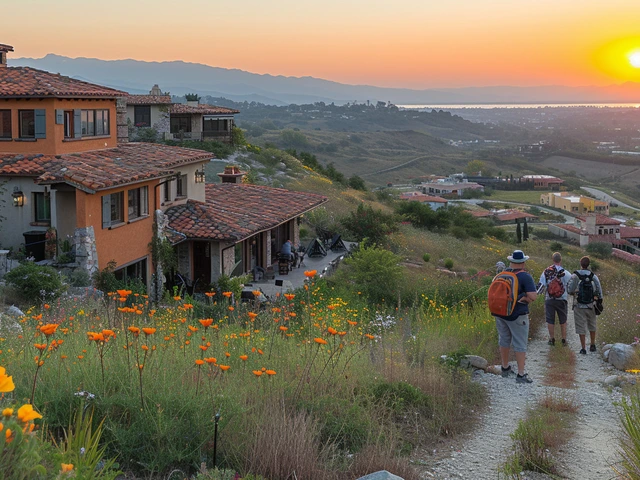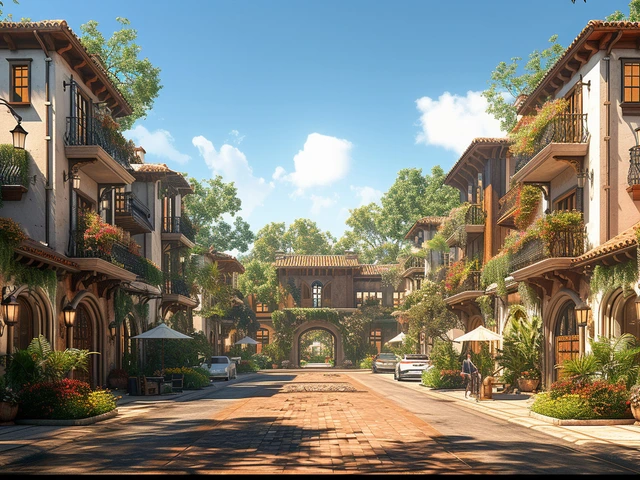A Stroll Through History: The Roots of Mediterranean Revival
Ah, Mediterranean Revival architecture – you’re like the seasoned traveler of design, picking up a little something from every port of call. Originating in the early 20th century, this architectural style became the jumping jack flash in the pan of American real estate, particularly in sun-drenched locales like California and Florida, where the climate said, “You betcha” to the breezy Mediterranean flair. The style itself whisks together a delightful concoction of Spanish, Italian, Andalusian, and even a pinch of Moroccan spice. Now, I'm no world traveler—I get a nosebleed going up a flight of stairs—but even I can appreciate the globe-trotting bonanza reflected in these structures.
I remember thinking to myself, standing in front of one such edifice, “Well, wouldn't you make a fine postcard!” The signature elements are as unmistakable as a walrus at a garden party – stucco walls the color of sun-bleached bones, red-tile roofs eager to slough off the rain, and, let’s not forget, those arched doorways and windows that look like they've been lifted from a Roman holiday. It’s all about creating the fantasy of a European vacation without the hassle of lost luggage and funny-tasting water. Mediterranean Revival is like the architectural equivalent of that friend who studied abroad and came back with a love for artisanal cheese and an unplaceable accent.
Why It’s Still Not Curtains for Mediterranean Revival
So, why does this architectural style continue to hold court in the realm of relevance? Well, first off, it's got charm to burn. Walking through a neighborhood full of these gems feels like you've stumbled onto the set of a movie where every day is a sun-kissed adventure. The blend of style elements works harmoniously, like a well-conducted orchestra, where the strings of Spanish influence play nicely with the woodwinds of Italian fancy. But it's not all about aesthetics. This architectural Dolce Vita is practical too. Features like thick walls and shaded loggias are nature's original air conditioning—because sometimes the old ways (and the old days) knew best.
In my neck of the woods, there’s a house that I like to think of as the ‘Grande Dame’ of Mediterranean Revival. It's grand without being ostentatious, classic without being staid. Every time I walk past it, I tip my metaphorical hat and think, “You've still got it, old gal!” These homes aren't just structures; they’re like good wine or George Clooney – they get better with age. And as someone who frequently spills wine on his shirt and is more of a ‘discount store brand’ than Clooney, I can say this with a certain level of expertise.
Key Characteristics: The Ties That Bind
Let’s dive into a mental exploration of Mediterranean Revival with all the gusto of a kid at a candy store. What sets the stage for this enduring style? Like the pièce de résistance of a three-course meal, the tiled roofs are the first bite; evoking the old world while fiercely preventing leaks better than that 'As Seen on TV' sealant. Stucco exteriors follow suit – they're not only about aesthetics but also about keeping interiors cool as a cucumber. Now, the arches – be still, my beating heart – they offer an air of romance and mystery as if at any moment, a swoon-worthy scene from a novel could unfold beneath them.
It's the attention to detail in Mediterranean Revival that captures the imagination. From wrought-iron balconies that make you want to burst into serenade to meticulously manicured gardens that buzz with the promises of secret rendezvous, it's like every element has a story to tell. And who doesn’t like storytime? I used to devour tales of adventures and faraway lands as a kid, and now, these homes kind of serve the same dish – escapism with a splash of sophistication.
Living with Mediterranean Panache: Modern-Day Considerations
Fast forward to today, and the practical side of luxury comes into play. People are still snapping up these homes quicker than a hot cake on a cold morning. Adaptations have been made to suit our 21st-century needs—yes, we're not all churning butter or sending messages by carrier pigeon anymore. Nowadays, Mediterranean Revival homes could sport solar tiles that blend in with the traditional roofing or utilize smart home technology hidden behind historic charm.
I've walked through modern reinterpretations of this style that make you swear you could hear Sinatra crooning in the background while a Roomba quietly goes about its business. It's an amalgamation of the best of both worlds – “Leave it to Beaver” meets “The Jetsons.” But, although we have the technology to reinvent these homes, there's still a keen sense of respect towards maintaining the original appeal that made them so enticing. It's like updating your grandma's recipe with organic ingredients—you want to make it better without losing the essence of what makes it special in the first place.
The Mediterranean Revival Echo Across the States
You might think the Mediterranean Revival style is as easy to pinpoint on a map as Waldo in a crowd of stripe-challenged individuals, but guess again. Sure, it has its strongholds—California with its movie moguls and Florida where the orange juice flows like water—but this style has made its mark coast to coast. In cities like Miami, you can't swing a palm frond without hitting a building that's strutting its Mediterranean stuff. The style has ingrained itself like a delightful urban décor meme, reblogged from sea to shining sea.
Miami Beach is the poster child for this style, with entire districts dedicated to this architectural look. Take the famed Coral Gables, for example. It’s as though someone took a slice of Spain and said, “Here, hold my sangria,” and plunked it right down in the middle of Florida. The very streets seem to whisper, “Bienvenido,” to everyone walking by, and city ordinances safeguard the style like a treasured family heirloom. These enclaves stand in stark contrast to the cookie-cutter developments that often sprout up faster than dandelions on a lawn, offering residents and visitors alike a splash of character in a sea of sameness.
Preservation Efforts: Keeping the Romance Alive
With great architecture comes great responsibility. Preservation efforts are key to ensuring Mediterranean Revival neighborhoods don't go the way of the dinosaur or, heaven forbid, become overrun by faceless high-rises. Advocates champion these structures like doting parents at a school play, ready to repair a chipped fresco or fight for historical landmark status. It's this dedication to preservation that allows new generations to stroll along and think, “Wow, they sure don't make ‘em like they used to.”
Towns with a strong Mediterranean Revival presence often have historical societies that are as protective as a mother hen with her chicks. Participating in these societies is like joining a club where everyone fawns over past architectural triumphs and rallies against the encroaching tide of modern monotony. I’ve attended a few galas (okay, maybe just looked in through the window) where the passion for these relics of a bygone era is palpable—spurred on, no doubt, by copious amounts of wine and canapés.
Mediterranean Revival in the Digital Age: A New Lease on Life
So, how do you keep a century-old architectural style relevant in the age of TikTok and Twitter? Well, just like everything else these days, Mediterranean Revival has gone digital. Social media is flush with accounts dedicated to the aesthetics of these elegant abodes. Suddenly, we're all art directors framing the perfect shot of ornate doorways and posting them with hashtags like #HouseGoals. It’s a whole new venue for appreciating the intricacies of design – an endless scrolling museum with no admission fee.
Instagram influencers take to these photogenic locales, sashaying down bougainvillea-lined paths like it’s Milan Fashion Week every day. And let’s face it, few backgrounds can elevate a selfie like an imposing colonnade or a vintage wrought-iron gate. These platforms have given Mediterranean Revival homes a second wind, showcasing their timeless grace to a worldwide audience who might be double-tapping from a skyscraper in Tokyo or a subway in New York.
Melding Classic Charm with Modern Sensibilities
As we march forward, toting our smart devices and clamoring for the next big thing, Mediterranean Revival architecture is like the sage old professor in a room full of start-up entrepreneurs. It reminds us that some things are worth savoring, worth preserving. By mixing the vintage allure with contemporary accoutrements, they remain as relevant as the latest app update—although arguably with more personality.
Homeowners and architects alike are finding innovative ways to infuse state-of-the-art technology and green living solutions into these handsome homes. It’s like meeting someone who can discuss the philosophical implications of Plato's "Allegory of the Cave" and share the latest hack for speedy Wi-Fi. It's heartening to see a fusion of the best bits of history with the dazzling opportunities of our times, proving that the Mediterranean Revival style is not simply surviving—it's thriving.
In closing, while styles and trends come and go, bobbing on the sea of cultural shifts like so many inflatable flamingo rafts, Mediterranean Revival architecture remains anchored firmly shoreside. It doesn't just cling to relevance—it waltzes with it, reminding us that good design, like true class, never goes out of fashion. Whether I'm writing about it or just admiring it on my morning stroll, I know it's a style that's here to stay – just like the perpetual twinkle in Clooney’s eyes or the eternal echo of Sinatra’s croon.





Leave a Comments